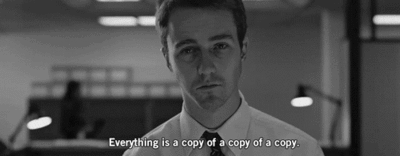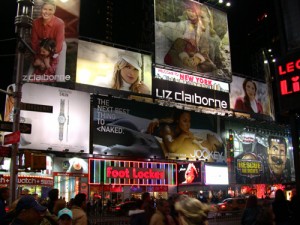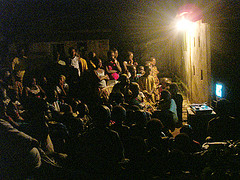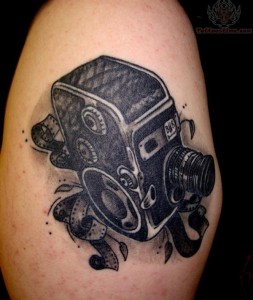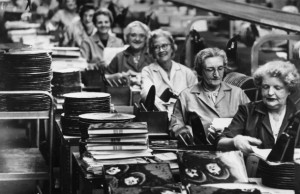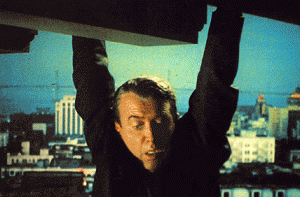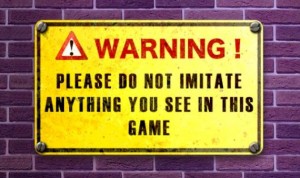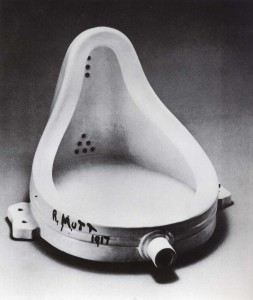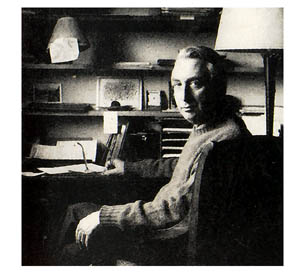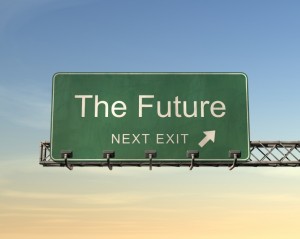I work with stolen pictures. They have been made by others, sometimes in trying or impossible circumstances. Someone (was it you?) waited out there all night and looked through the good light with their machines of seeing and found on the other side a corn field, two hands holding, a face. Today we can uncover a lot of these pastimes on the internet, and it’s not so hard to make a little digital welcome mat and load them onto the hard drive at home. Those tears: they’re my tears now. That face, it’s staring back at me from my very own computer screen. It seems hardly fair, right? After all those trying moments, all that gear hauling and waiting and hassling with money and impossible producers, some poser is going to take a lo-fi copy of a copy of your genius seeing and call it their own. Sign their name to it no less. As if it was never yours at all. As if the pictures you made didn’t belong to you.
Landscape
When I look out my window I see a highway that flows day and night in both directions. Like most Canadians, I live in a city. Pictures are part of this city of course, and most are not made by me. This received wisdom is hardly accidental, great efforts have been made, vast sums have changed hands, so that certain sneakers or faces can look at me again and again. These pictures, more than my corner store, or the park that waits between my apartment and the lake beyond, are my neighborhood. My home. When I was a child TV quickly became a common language. It is what “we” had in common. Meanwhile, on the radio, Liverpool’s fab four were doing their bit to make “us” possible.
The mediascape is my landscape.
Even though I have a taste for the arcana of the motion picture world, the diary trysts and rooms without corners, the one night stands and the fifteen minute epic that takes a lifetime to make, most of my mediascape is filled with expensive pictures produced by corporations. They have been strictly designed for one-way transmission: the money people produce, the rest of us consume. That’s how it’s supposed to work anyway. It’s a big picture, the audience is listening and you can hop discount flights every night and catch the same movie in cities all over the world. In some quarters this is still known as free trade. The global village has come home.
Take a quick look at your hands for a moment, then come back to rest here. In that instant of looking how many pictures do you think have been produced around the world? Hundreds? Thousands? Hundreds of thousands? The picture factories – and who isn’t a picture factory these days? – like the highway outside my window, are busy day and night. But despite the existence of too many movies, just a sliver of them are really visible. Most are seen only by their makers. Oh Dad please, not again. The pictures on display offer this cheap come-on: you can be part of it too! Movies used to be the art of the working class, big pictures for little people. TV is free, or sort of free, or at least the bottom end of TV, sans cable, sans digital box, because that’s for everybody, right? Because these pictures can be found “everywhere,” and because they’re not difficult to understand (oh, I get it!) they offer the illusion of proximity, even access. You can be a player too! It’s like strolling down Hollywood Boulevard and looking at the stars’ names under your sneakers. Close baby, those stars are so close. But there is a lie at work here: those easy to digest, glossy, funny, beautiful pictures, filled with glossy, beautiful stars, are never going to be your pictures. You can pay to see them, or wait until they make it to TV, but you’re never going to be able to make those pictures or appear in them. It’s a one-way street, and you’re on the end that pays. And if that feels good (hey, I LOVE the work of (fill in your fave director’s name here)) all the better. It’s supposed to feel good. You pay the money to keep the machine of pictures working, and they’re so hipped to desire (they help create it after all: stars are made, not born) that you don’t mind shelling out when they decide to change formats all over again. Hey, don’t fight the feeling: the natural order of things is that the rich have a right to all their money and power while the rest of us learn to get along. If we were better people we would be rich too, and maybe we’d even get to make some of those rich movies.
Unless.
Unless you print invitations to your own party. Unless you decide that small pictures could be made that didn’t need to appeal to “everyone.” Perhaps some of these small pictures could extract (or quote, or lift, or strip-mine, or steal) moments of those so-available pictures and put them to other uses. Of course many will continue to defend the right of the rich to do as they please. That’s why we have law courts and government and copyright legislation. But what if? What then? Could different stories be told? If we could tell stories differently, from our small place, using these borrowed pictures, would that change the way we told our own lives?
Analog versus digital
In the old analog world copying was a drag. Sure it was possible to make a copy of vinyl records: how else were they going to make enough to put into all those stores? But you needed a big operation, a factory with large runs, in order to dupe all that vinyl. Capitalism requires constant restocking of the marketplace. Make it new! And the new thing is: eight track tape! No scratch that. Cassette tape! No wait a minute. The new thing is: CD! At least for now. CDs will be extinct one day soon, you’ll mention them and someone will peg you right away as one of those freaky nostalgia buffs. It will date you as sure as wearing Capri pants or saying the word ‘like’ a thousand times an hour. That’s SO 2012.
Today everyone I know is busy copying. Text files are transferred, emails forwarded, pictures swapped, music downloaded; it’s a copy crazy world. Digital media makes it so easy. But if you want to make a copy of an old fashioned analog film? Ouch. There’s a special camera which lets you shoot thumbnail size pictures one frame at a time. In an hour you might shoot two or three minutes, without sound of course, and your precious copy will have to be processed at the lab before you can see it. I spent my early years crouched beneath this machine and hope never to see it again. You want to make a copy of a video? Download the file and it’s right there. Attach camera and VCR and hit the record button. The vinyl factory is now the size of a chip.
Digital vertigo
In the digital world there is no original, therefore no copies and no copyright. Digital information can be words, or pictures or sound, it doesn’t really matter. In the analog world all those moments were separate: you can’t take pictures with a typewriter. Digital files are collections of zeros and ones, and replicating that arrangement on your desktop means we both have the same file. There is no difference between the new file you’ve just copied and the one on my computer, supposedly the “original.” In the old analog world copying meant loss of quality, or even worse. A Xerox of a painting is not a painting because it’s not made of paint. But a digital file of a Word document is still a Word document. Ready for a little digital vertigo? Here goes: the copy is the original.
Titles
I remember working on a movie at an editing bench. Real filmmakers, I had become convinced, didn’t require machines to edit their work. They could feel each shot simply by its length, they could roll out a metre or half a metre, or just a few frames and make a splice, bang, and then move onto the next shot and haul out a bit of that, bang, then return to the first shot, and cut it altogether. I was a wimp. I needed motorized editing machines to do the work for me, to show me what it would look like running through a projector. But sometimes, the same way that those old priests would walk out into the desert with their hairshirt on, I would sit at an editing bench and cut my movies. I was up late one night at the co-op laying titles on a couple of new numbers before going home. Months later I was sitting at an open screening, where anyone could come along and show their wares (how much patience I had then! How much time!) when I saw someone had used my title outtakes (the trims, the extra) for their movies. They hadn’t simply copped the name of my films but the actual film stuff itself, which was hand processed, scratched and bleached in a very particular way. I started laughing. Somehow the idea that two movies would live beneath the same title struck me as a particularly good idea. Why not give every movie the same name? And every author.
Recycling
There must have been a moment in the history of motion pictures where it was possible to see every movie. At the beginning for instance. It helped that movies were short, you could watch ten or twelve in a sitting and still make it home in time for dinner. It helped that there was only one camera in the whole world, that film stock was expensive and had to be made slowly, in lengths which were about a minute long. But after movies became business, even early film buffs had a hard time keeping up. All those different countries churning out moments. Who had time to see it all? And then movies began to get longer, and came out like machine gun reports, ratatat, one after another. Not long after movies began there were more than anyone could possibly see. And not long after that some became landfill. The films of the French genius Méliès are the most well known examples. He’d been a magician but turned his head towards the possibilities offered by the new moving pictures. He made dazzling things, at least from the evidence of what has survived. But most of his work has not lived on, he died penniless and forgotten, and much of his work was thrown away or lost or vanished in fire. Where have all those movies gone, the hundreds of prints of Star Wars and all the other inner space epics? Once their moment has passed, once they no longer quicken the pulse, where do they retire? Are we living on a garbage dump of pictures, ignored in our rush for the new? Bring on the new!
What movie pirates like to do is to dig up some of these forgotten moments, or even some not-so-forgotten moments. Take a step back in order to take another look, a second look. Use that moment again and put it towards a different end. What I’m talking about, of course, is recycling. It occurs in most urban ecologies, no great surprise when it is located in the region of motion pictures, right or wrong?
Origins
I wonder who was the first artist who stole. Duchamp signed a toilet he didn’t make and called it sculpture. Is that stealing? Picasso inverted a pair of bicycle handle bars and said those are the horns of a bull. Is that stealing? Picasso again and his friend Georges Braque lived in a shattered space which they painted up and called Cubism. Occasionally they would add a little something to the surface of the picture. The wrapper of a cigar for instance. No question, that was definitely stealing. But what about the first “artist” whose work can be found in the cave paintings of Lascaux, depicting animals in the hunt. This replica of nature, wasn’t this also copying? Or is that something else? Magic perhaps. Shamanism in paint. Doesn’t art begin with the act of mimesis? I like that, I want to be like that or look like that. I want to make something look like that. From the weekend painters to the film school kids who want to remake noir classics with $50 on their neighbour’s back lawn, the urge is to repeat. The impulse to create, at least in the beginning, is always about copying.
RB
And of course, for many of us, and our work, the precious beautiful jewel-like files that we are going to submit to our computer gods, are going to remain at the level of copying. Our work might be footnotes in the vast machine of overproduction that is cinema today. Why is that exactly? Why is some work so beautiful, so necessary? While so much else is OK, or it’s necessary and burning and bright for one moment, in one room, for one face, but not for two faces. Or it burns bright for two rooms, but not for three? You bring the same file to another city and it doesn’t even look like there’s a picture on the screen. Why is that exactly?
Perhaps we could put this question to Roland Barthes. In his genius book Camera Obscura, he rewrites the history of photography as a family history. As if it were his history. Every photograph ever made, he finds it in the picture of his mother. But wait, before all that. He is confronted with a condition that will be very familiar to you. He is vexed by the problem of too muchness. There are too many photographs. Have you ever felt this? I can’t look at them all. Our computer gods have permitted an accelerated proliferation of data – pictures, words, sounds – it is a machine, a network of machines, that offers us the three primary arms of cinema – the father, the son, and the holy ghost. I mean of course production, distribution and exhibition. There are so many movies being made right now, and they are being shown in so many places. What are we supposed to do with this too muchness?
In Camera Obscura Barthes tries to take this on, and I think it’s helpful to imagine him, at his writing desk, before the advent of the personal computer, writing by hand, while all around him there are great heaping stacks of photographs. What is my relation, mostly, most of the time, to this heap of pictures that surrounds me? Barthes, who was really a poet disguised as a critic, came up with a single word to describe this relationship. He reaches back to an old Latin culture and finds this word and he brings it back, he breathes new life into it, and the word is: the studium. What does it mean?
Barthes calls studium “a kind of education (civility, politeness)” – civility or civic – it has something to do with being a citizen, with participating in civic life, life with others, our relational life in other words. What are the codes and protocols for how we interact with each other? This has something to do with politeness, with decorums, with observed rituals. And we could gather all that up, perhaps, and call it culture. Culture is central to this figure of the studium, as Barthes puts it “it is culturally that I participate in the figures, the faces, the gestures, the settings, the actions.” Barthes says that culture “is a contact arrived at between creators and consumers.” Barthes cites journalistic photographs as good examples of studium, saying, “I glance through them, I don’t recall them, no detail ever interrupts my reading; I am interested in them (as I am interested in the world) I do not love them.” Isn’t that so beautiful? I know what they are, I can recognize them, there are recognizable forms in the photograph because they are part of – we are part of – the same culture. I know what it is, but I do not love it. And then he goes on to say, and this is a killer: “What I can name cannot really prick me.” We’ll get back to that in a moment. But for now, perhaps we could say that the studium is part of the known, and the known part of the world, the part of the world that can be known and named, is not the most important part.
It’s a radical idea isn’t it? The most important part of the movie you’re making, is not something you can actually know. The most important part of your life, is not something you can name. There are vast and unconscious forces at work, and while we like to imagine we are in the driver’s seat, the road, the view, perhaps even the vehicle itself, is all part of the unconscious. Perhaps all we’re really doing is pressing the accelerator a little more and a little less, and imagining that the accelerator is the whole world.
OK, OK, but we’re back with Mr. Barthes, he’s surrounded by photographs, and then there is one photograph, or perhaps there’s more than one. Oh. This photograph, it touches me. It’s so special. It’s not like the others. There is the problem, perhaps we could call it the condition, of the too muchness, and then something arrives out of this ground. Out of the ground of this culture, this received body of meanings, there’s a photograph that touches you. Why is that photograph meaningful or special, and not the others? Barthes has a word for that too, also from the old Latin. He calls it “the punctum.” The punctum, the piercing point.
“The second element will break (or punctuate) the studium. This time it is not I who seek it out (as I invest the field of the studium with my sovereign consciousness), it is this element which rises from the scene, shoots out of it like an arrow, and pierces me. A Latin word exists to designate this wound, this prick, this mark made by a pointed instrument: the word suits me all the better in that is also refers to the notion of punctuation, and because the photographs I am speaking of are in effect punctuated, sometimes even speckled with these sensitive points; precisely these marks are so many points.” (26-27)
It’s not the whole picture, OK. The whole picture doesn’t pierce you. But some moment of the picture, some mark, some pictures are speckled with these marks, what he calls “sensitive points.” And they effect you, not everyone for all eternity, they effect you, they are sensitive to you, they speak to you. How does he describe his relation with most pictures? I understand them, I respect them perhaps, but I do not love them. And how does he describe the pictures that are most meaningful to him? The picture loves him. Is that too much to say? And what is the mark of this love? Ouch, it wounds me, it hurts me. It’s unexpected, it’s personal, for Barthes, the act of love, means being pierced. The price, the cost of admission, of admitting this picture, of admitting, of allowing in, of allowing entry, of opening, the cost of opening is being wounded. Pierced. When you’re pierced it creates a wound. An opening, a hole. You allow the picture to hurt you, and in this moment the picture that was over there and far away and part of some general cultural assembly, is very close, intimate, it’s part of you It’s part of who you are, part of how you recognize yourself.
Some people when they work with pictures, whether their own pictures, or other people’s pictures, they stay at a safe distance. They stay at a copying distance. The distance of the studium. While others are opening themselves, allowing themselves to be hurt by the pictures that they are making. Allowing themselves to be seen by the pictures they are making. Allowing, admitting the other side of the camera to look back. So that the act of looking, which is traditionally conceived of I’m in here looking out of my bunker, instead you open, and allow yourself to be seen, to be part of the scene, part of the visible world, as our physicists tell us, we are always part of the scene, part of what we are seeing. And then there is yoga, the yug or yolk, which we might translate as intimacy. There’s contact. And that is a powerful place to make work from. It can often be a difficult place, and some artists create these very difficult situations for themselves, so that they can live in the tapas, the heat, of these contradicting demands, and find a way to open again to their pictures. It’s difficult to live with an open heart. It’s easier to stay here, in the studium. Where I can live with my borrowed words, with my borrowed ideas, with my borrowed emoticons.
The author
The author. The authority. The creator (“in the beginning was the word”). What does it mean to be the author of a stolen text? Kathy Acker wrote a book called Great Expectations. Sound familiar? She would lift chunks of the classics or economic tracts or anything really except the sex scenes which, she insisted, she liked to write herself. She cut and paste, a collage artist to the end. Did this become her signature, the thing she was known for, the Kathy Acker look? Or was she (also) pointing to a secret buried at the heart of every book, that they are made with words which have not been invented by the author. Even the arrangements of these words which we like to gather in tomes called books, or magazines, or newspapers, even these orderings are not the exclusive preserve of the author.
“Hi, how are you?”
Did I just say that? Or did you? Or did someone write it, once, for the first time? When I say this to you, when we meet together, am I the author of this statement because it’s coming from me? Or is it coming from somewhere else, and living through me? Has it entered me like a virus and occupied space in my linguistic imagination, and slowly colonized my language, my ways of thinking, even my ways of unthinking (remember Lacan’s famous slogan: “the unconscious is structured like a language”)? So much of me (the way I think of my body, the way I imagine past and future, notions of vocation, familial relations, all this to name only a little) seems borrowed. Sure, I might make a small variation on the great themes, but even these variations have been played out before, by someone not so unlike me.
“Hi, how are you?”
Hard to imagine that authors are enough to hold back the floodgates of these greetings. What if we had to invent words every time we met each other? What if we lived in a world of authors and weren’t able to recognize any greeting that had already been dished? Every hi and hello would sound like so much noise. Is that our hoped for utopia, our dream come true?
I Want My MTV
Sometimes I sit through a really awful movie which has one beautiful shot in it (and is it just me?) but I hear that shot crying out for rescue. Help me! I am stuck in this terrible movie, please rescue me! Leave it to the collage artist, the “found” footage maker. She or he is busy finding these moments and laying them down on new tracks.
Many rock videos, to take just one example, are mostly banal adverts featuring twentysomething bands pretending to sing or play the usual instruments. But sometimes a moment arrives, the light coming off a face or a car tire, some real moment of looking has occurred which is waiting to be released from its role of boosting CD sales.
Using someone else’s pictures I become a ventriloquist. I “throw” my voice. I project these pictures backward, not “everywhere at once” (the dream of broadcast) but back into the small holes of my life. I take it personally. Once I’ve got these moments up inside me, once I admit them, then they’re ready to appear again. Fountain by R. Mutt.
Drawing a Line
I walk through my front door and close it behind me. I’m inside my apartment which means also, and more importantly: my apartment is inside me. There are four walls and a door which lets me in and out. I have an interior space where I can keep everyone else out. Everyone. My apartment is a picture. It’s a picture of how I imagine myself. I am also someone who closes and opens, and I have an interior space, a “personal” life, a “private” life. This private life is walled in by my body (which is like the walls of my apartment). Other things are also like the walls of my apartment. I am a master of walls, I’ve been busy building walls all my life. The words I use, the way I move through the city ensuring minimum contact, all this says: stay away from my interior place, my apartment, my privates.
My apartment draws a line between what is mine, what is me, and what is not me. Copyright works the same way. Copyright makes a picture which figures people with an inside and out. But what if that line is dissolved, what if copyright doesn’t exist any longer? What if private property were abolished? It would mean not simply a new kind of social order (and no, I’m not up on the Marx stump here), but a new kind of human being. Imagine a person with no dark interior, without an “unconscious,” with no private or personal self to hide any longer. I believe that this is the kind of person that already exists, as a picture, in our digital technologies. We have not become those people yet, but we are already on the way, and we are getting there fast.
Twenty years ago there were few home computers, and offices meant typing pools and shorthand. Today computers are everywhere, worldwide, a digital technology embraced, updated and paid for, then paid for again. It is a technology which has been admitted into the home and this is critical. Because once inside the home the digital picture is busy changing what home is. The agent of conversion is at work, no arm twisting necessary, no painful trials required. Or at least not yet. For now we are happily turning this exercise into a necessity. “You don’t have email?” my friends asked, aghast, only a few years back. I was holding off because I knew that once I began, it would become unavoidable, essential even. Today I log on like millions of others. I rely on it, I am becoming digital, transparent, dissolving the walls I have so carefully built over the years. And if it’s not making me happy I know that’s changing too, the four walls of happiness I’d carefully built along with everything else.
The pictures I make, which are only recombinations of pictures that already exist, are part of this change. Don’t get me wrong, I am not a missionary for some new kind of human being. Like everyone who owns or uses a computer, I’m going with the digital flow. The new people we are busy becoming. On some days, even deep inside my apartment, it smells like the future.
